27 ways to save money on your chickens and their feed bill.
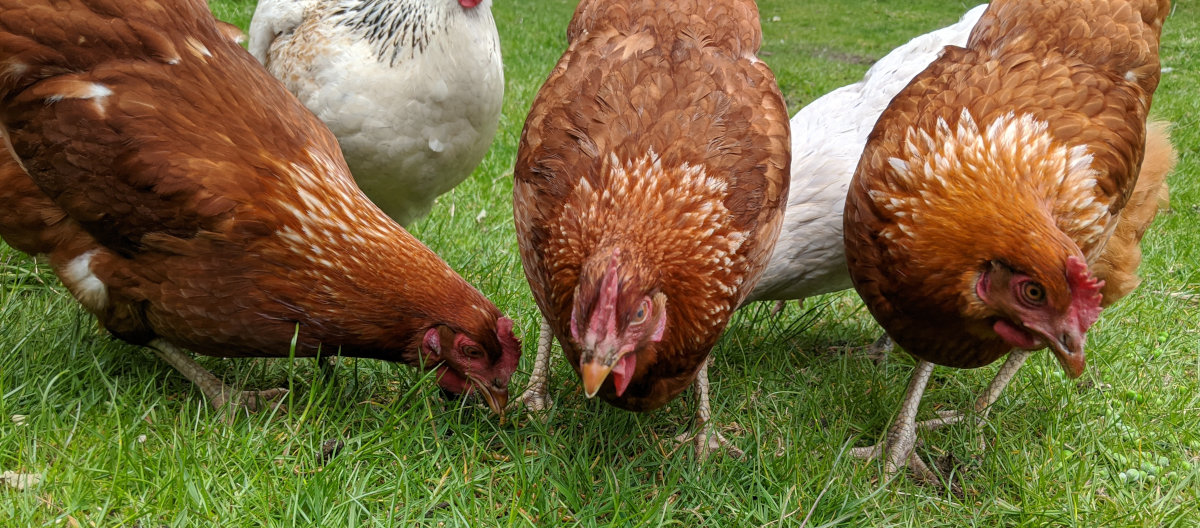
I have to admit I was truly surprised by the interim results from our chicken keeping survey with 9.6% of 510 people who replied so far having struggled to feed their flock on occasion.
Below: A visual representation from our chicken keepers survey of how many people have struggled to feed their flock of chickens.
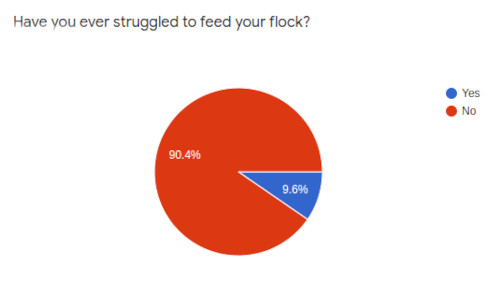
Then I sat down and worked out how much it costs me to keep my chickens for a whole year.
Table of Contents
- How much does it cost to keep a chicken?
- A few guidelines before you start:
- Coop bedding and floor coverings:
- Get white egg layers or hybrid chickens.
- Buy POL fully grown chickens or reared pullets:
- Free range your chickens if you can:
- Don’t keep a cockerel.
- Don’t overfeed your chickens.
- Forage for chickens feed.
- Find a farm or agricultural veterinarian.
- Ferment your feed.
- Shop around and have chicken feed delivered.
- Plan your year.
- Plant a fruit tree or bushes.
- Use a specialist animal feeds merchant.
- Buy in bulk.
- Buy direct from a farmer.
- Deal with rats, mice and other pests.
- Get to know a local brewer or baker.
- Produce your own worms, bugs and insects.
- Cut down on treats or make your own.
- Feed weeds or flowers:
- Get extra chickens:
- Try mixing your own chicken feed:
- Sprout grains or produce forage for your flock.
- Feed table or kitchen scraps:
- Keep a backyard garden and feed the extras to your birds:
- Reduce the size of your flock by culling old laying hens:
- Save money on grit and shell.
- Don't buy dust baths, nesting boxes, roosts or perches.
How much does it cost to keep a chicken?
A single chicken in my flock will eat 55 Kg of chicken food per year and the cost at current prices is £25.74 ($36.11) per year. This is based on 150 grams of feed per day and April 2022 prices.
It should be possible for the average chicken keeper to reduce the cost of keeping their chickens by a third.
Feeding chickens cheaply is always going to be a balancing act with nutrition.
A few guidelines before you start:
Not every method of saving money will work for everyone, start where you will make the biggest returns.
Always introduce new food to the flock gradually and soak grains in water for chickens that have never been fed them before.
Never be tempted do overdo a saving, adding to much grain, scraps or fruit into the diet of a chicken that is not used to it may make it sick.
Saving in money terms often requires you to trade some time in return.
Some money saving methods require space which not everyone has.
The ways I have saved money on chicken keeping:
A few years ago I was working for a charity and very short of money and often found myself short of money at the end of the month.
Some of these methods are quick easy wins and some take time and only return 1 or 2 % savings over the year.
A bonus money saving tip is to not keep ducks, turkeys, geese, quail or guinea fowl if you are on a tight budget, these types of poultry all cost much more than chickens.
Coop bedding and floor coverings:
Use sand or deep litter instead of shavings or straw. Both are cheaper and easier than wood shavings. You can even use dry leaf litter if you have woodland.
I buy sharp sand from my builders merchants for £2.65 for 25 Kg whereas a bale of wood shavings is nearly a tenner.
Chicken poop is much easier to clean off sand and it can be spread in the garden when finished.
I switched to sand in the coop from very early on in my chicken keeping career.
Make use of droppings boards under the perches to catch all the night time droppings in one easy to clean convenient location.
Amount saved over 1 year : 15 to 20% of cleaning costs.
Get white egg layers or hybrid chickens.
Brown, green and blue eggs may look lovely in the basket when you collect them but the insides are no different and coloured egg layers are less productive than hybrids and white egg laying chickens.
Below: Red sex link like these Lohmann browns are the best layers.
Keeping breeds that have been bred specially to need less feed will give you a better egg to food ratio.
Examples of breeds of chicken that have a good feed to egg conversion ration are:
- Cinnamon queens,
- Rhode Island Reds,
- Golden comets,
- Leghorns,
- Lohmann or ISA browns,
- Light Sussex,
- Red sex links.
Heritage or rare breed poultry may look beautiful in the garden but they take longer to grow and are more expensive to keep at all stages of their life.
Amount saved: White egg layers or hybrids lay as many as 60 or 80 more eggs per year.
Buy POL fully grown chickens or reared pullets:
Raising your own chicks is expensive and time consuming. Buying point of lay or reared pullets guarantees they are female and ready to lay.
Do not get rescue or Ex-battery chickens if you are trying to save money, they are called spent hens in commercial operations for a very good reason.
Below: Getting rescue hens is noble but expensive and time consuming.
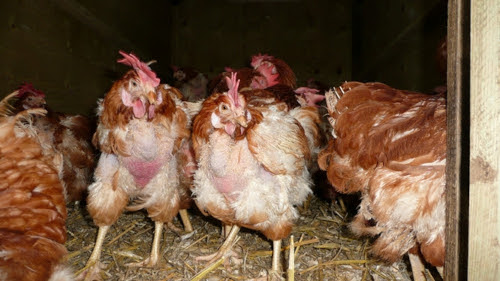
Amount saved: Varies depending on circumstances.
Free range your chickens if you can:
Raise your chickens on pasture or let them free range, even if it is just for a few hours in the evening.
Below: Free range on pasture if you can.

Free range chickens can find as much as 40% of their own food, especially in the warm summer months. Chickens also graze on grass, mine really like the fresh green tips.
Amount of saving: 15 to 20% over the year.
Don’t keep a cockerel.
A single large fowl cockerel will consume 54.75 Kg of chicken feed a year and provide no return at all. At the cost of my pellets this equates to £25.74 ($36.11) per year.
If you would like to breed chickens, cockerels can be borrowed for a week or two early in the season.
Amount you save = 1 / number of chickens in your flock so if you have six hens you will be saving one seventh of your costs.
Don’t overfeed your chickens.
Stop feeding ad lib.
Feed your birds first thing in the morning and make sure everything is consumed before giving more feed.
Chickens will eat between 100 and 150 grams of food per day depending on the season and the type of feed-stuff.
Start by weighing out 100 grams per bird and feeding first thing in the morning and then give a top up or a good feed of scratch before bedtime.
Reduce waste with feeders that prevent chickens from scratching feed out onto the ground.
Amount saved: 5 to 10%.
Forage for chickens feed.
There are a few wild foods you can collect from the environment which are a good feed for chickens.
Hawthorn berries and mountain ash berries are easy to collect, dry and store and are nutritious. These can be collected when ready in the Autumn, heat treated in the oven and stored for months if necessary.
Sea Buckthorn is another plant that produces masses of edible and nutritious berries.
Edible seaweed is an excellent feed additive for chickens, it contains all sorts of salts, minerals and iodine and can be collected from the seashore, chopped up small and dried. Seaweed only needs to be 1 to 2 % of the diet
Elderberries can be collected but should only be fed in tiny amounts as they contain compounds that cause diarrhoea in birds.
Amount saved: 1 to 3% per year.
Find a farm or agricultural veterinarian.
When I take my chickens to a small animal vet the consultation fee is £31.65 + tax and when I go to a farm vet the fee is £11.75 and some services and medicines may be tax free.
Farm vets also seem to prescribe large containers at lower prices often also tax exempt.
It has it's downsides, you often have to wait as there is no appointments.
Ferment your feed.
Fermented feed is easy to do and beneficial to chickens between 10% and 30% of the diet.
The real advantage to fermenting chicken feed is that it enables you to be able to feed cheaper alternatives, like barley, safely to chickens.
You should never ferment chicken feed like pellets as it is already formulated to be a complete foodstuff and you alter the nutrient profile during fermentation.
Amount saved: 5% per year.
Shop around and have chicken feed delivered.
Finding special offers is a bit obvious but having something delivered for 4.99 might be cheaper than your gas going to fetch it.
My feed merchant delivers free is I spend more than £60 ($80) which saves me nearly an hour and 11 miles each way in traffic.
Amount saved: Varies.
Plan your year.
If you treat your hens for worms and coccidiosis, make sure you do it at the end of the laying season as they chickens are moulting and their egg production is low.
You can’t eat the eggs during treatment and for a week or two after so any eggs produced during this time have to be cooked and grated and fed back to the chickens.
By combining the moult with the worming and other treatments you are wasting fewer eggs.
Amount saved: 1 to 2% per year.
Plant a fruit tree or bushes.
My grandfather always kept his poultry in an orchard, the birds eat the pests, the windfall fruit and have a great time scratching under the trees and the leaf litter for tasty morsels.
Below: Fruit trees, like this crab apple are hugely productive and drop fruit for months.
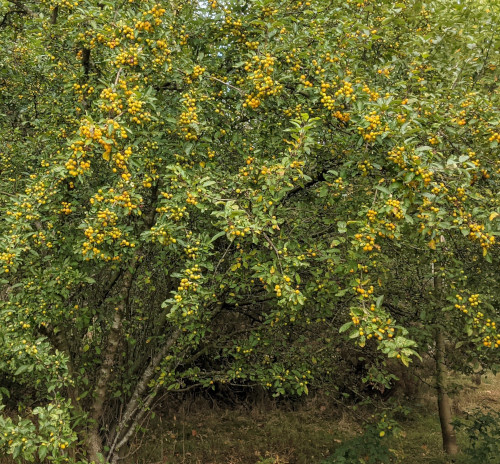
Soft fruit bushes can be grown for nothing from cuttings and produce a decent crop of berry fruit year after year for the chickens to help themselves to.
Amount saved: 2 to 4% per year.
Use a specialist animal feeds merchant.
Get to know your local animal feed merchant and ask them what is currently the best value feed as it changes during the year.
When I was struggling to keep my chickens fed a few years ago he helped me out by giving me a really good deal on damaged sacks of feed.
Amount saved: Varies.
Buy in bulk.
It makes economic sense to buy the largest bag of chicken feed you can deal with and store.
At my feed merchants the same brand of layers pellets is £5.89 for 5 kg and £17.99 for 25 kg making the smaller bags 1.63 times as expensive as the larger.
Amount saved: 10 to 20%, sometimes more.
Buy direct from a farmer.
I teamed up with two other chicken keepers and once a year we would visit a friendly farmer and collect a ton of wheat.
We had to bag it ourselves and store it safely but we were able to buy it for £3.50 ($4.60) per 25 Kg sack.
You can find growers of farming forums or Facebook groups.
Deal with rats, mice and other pests.
It is estimated that 20% of food is lost to rats and vermin and chicken keeping is no different.
Rats, mice and wild birds will help themselves to your chicken feed in a flash.
Amount saved: Up to 20%.
Get to know a local brewer or baker.
The byproduct of beer is spent barley or wheat which can be used to supplement the diet of chickens up to 10% without any ill effects.
Likewise while chickens should not be eating much bread, but the odd loaf, dried into slices so they have to peck at it and fed at the rate of a few pieces a week will do no harm at all.
Barley that has been used for brewing can be dried or frozen and stored or added to scratch.
Amount that can be saved: 2 to 5%
Produce your own worms, bugs and insects.
Chickens love earthworms and other bugs. Use organic matter in soil to produce earthworms.
Bury grass clipping or other organic matter in shallow pits in the soil and leave the worms to do their job for a few weeks and then dig a bit over and let the chickens go hunting.
Build a pile of logs and sticks and leave insects to colonise it then move bits around every now and then and allow the hens to scratch the bugs out.
Below: This is a woodlouse and my hens love these. They can be produced in their thousands in damp layered wood piles.
Keeping a compost pile has the same effect, you can harvest the worms every now and then for a treat.
Amount saved: Up to 5% depending on your location, weather and space.
Cut down on treats or make your own.
Most chicken keepers I know spend far too much money on treats. Your chickens will love you anyway, it doesn't take meal-worms.
The latest treats I have for my chickens is a sack of yellow peas which I am currently sprouting and feeding three times a week.
Below: Chickens love sprouted seeds.

A 25 kg sack cost me £16 ($21) and will last months as I am only using 300 grams or so a week.
Feed weeds or flowers:
Certain weeds and flowers are quite useful for feeding chickens.
Dandelions are a prime example, they grow quickly in all soil types and produce leaves and flowers both early and late in the season when other greens are in short supply. The roots are also edible.
Exactly which ones you can use will depend on your location.
Amount saved: 1 to 2% per year.
Get extra chickens:
Getting a few extra birds if you have the room, might seem like an odd way of saving money but the profit from selling the eggs will help pay for your chickens.
300 eggs per year, sold at 15 pence (20 cents) each will bring in £45 per year ($60). This is enough to pay for 50% of the feed of one other chicken as well as its own food.
Feathers and manure are other ways of profiting from chickens.
Amount saved: 20 to 30%. Not so much a saving as a source of income.
Try mixing your own chicken feed:
Your chickens should be getting at least 80% of their feed as a quality layer mash or pellet.
The big advantage of mixing your own chicken feed is you get to use cheaper or seasonal produce to bulk out.
A list of grains that can be safely fed to chickens:
- Wheat up to 10% of the diet,
- Barley up to 4% of the diet,
- Oats up to 5% of the diet,
- Sorghum or Dari up to 10% of the diet,
- Rice up to 15% of the diet.
Wheat on its own is not a good feed for chickens but it can be mixed at up to 10% with layers ration.
Don't be tempted to overdo the amount of grains in your chicken feed.
Amount saved: 5 to 10% per year.
Sprout grains or produce forage for your flock.
Sprouting grains or producing forage is another good way of utilising cheaper foodstuff over time to enhance the diet of your flock and save some money.
Both barley and oats cost me half what a sack of layers feed does and with an overnight soak in water and a day to begin sprouting they become an acceptable food for chickens.
Amount saved: 2 to 5%
Feed table or kitchen scraps:
This is not allowed in the UK or Europe but if you live elsewhere then the feeding of table or kitchen scraps is fine in small amounts.
Avoid overly fatty, salty or sugary foods and never give mouldy or rotten foods.
Cook damaged eggs and feed them back to the flock.
Amount saved: Depends on your leftovers and kitchen routine.
Keep a backyard garden and feed the extras to your birds:
Grow your own peas, grains, sunflower seeds, root vegetables and corn.
Below: A single sunflower plant produces well over 1000 seeds that can be added to chicken feed when dry.
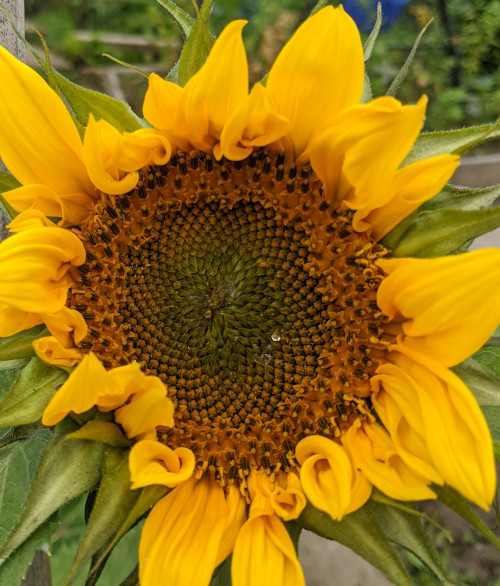
I had a couple of plants last year that produced nearly a pound of seed each.
Peas are easy to grow, productive plants that crop over an extended period. Peas are also an excellent food for chickens. Any left at the end of the season can be dried for later use or sprouting.
Below: Pumpkins produce large fruits, often filled with several pounds of seeds and orange flesh which can be stored for a long time.
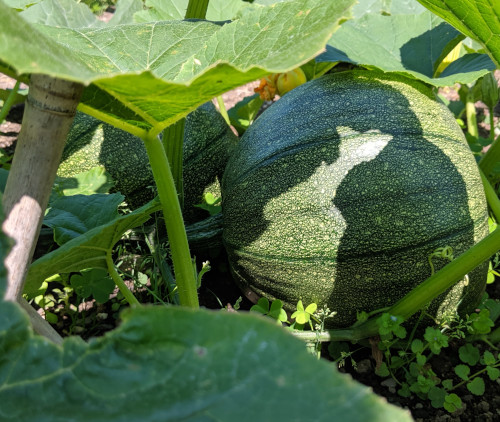
Amount saved: Depending on the crop, weather and circumstances, as much as 10%
Reduce the size of your flock by culling old laying hens:
Hens older than three years are a financial black hole, they produce few eggs and are more likely to suffer egg production and health problems.
Amount saved: Varies.
Save money on grit and shell.
A chicken requires 30 to 50 grams of stones or insoluble grit every year. Free range chickens will find this themselves or you can forage for and collect a supply of small stones.
Below: Egg shells can be roasted and crushed and added to chicken feed.
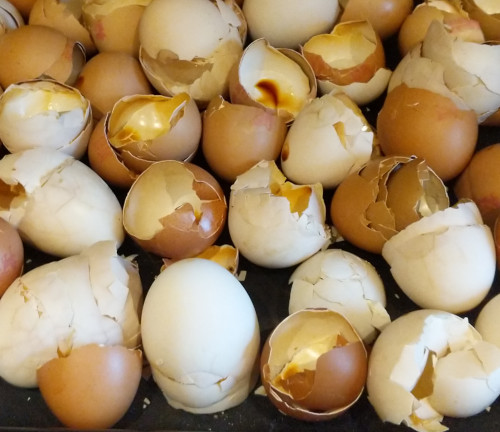
You can substitute the soluble oyster shell with the empty shells from your hens own eggs after you have enjoyed the contents. Dry in the oven for a few minutes when you are cooking and crush the roasted shells into flakes and add back to the feed.
Layers pellets or mash is a balanced feed that has enough calcium to keep your hens laying happily.
Amount saved is £3 ($4) to £5 ($6.50) per year per chicken.
Don't buy dust baths, nesting boxes, roosts or perches.
Roosts and perches can be made with branches from tree that have their bark stripped and been allowed to dry in the sun for a week or two.
Just about anything can be repurposed as a nest box so long as it is open on one side and is sturdy enough to take the weight of a chicken.
You don't need to buy a dust bath either and wood ash from a fire is an excellent filler for a chickens bath.
